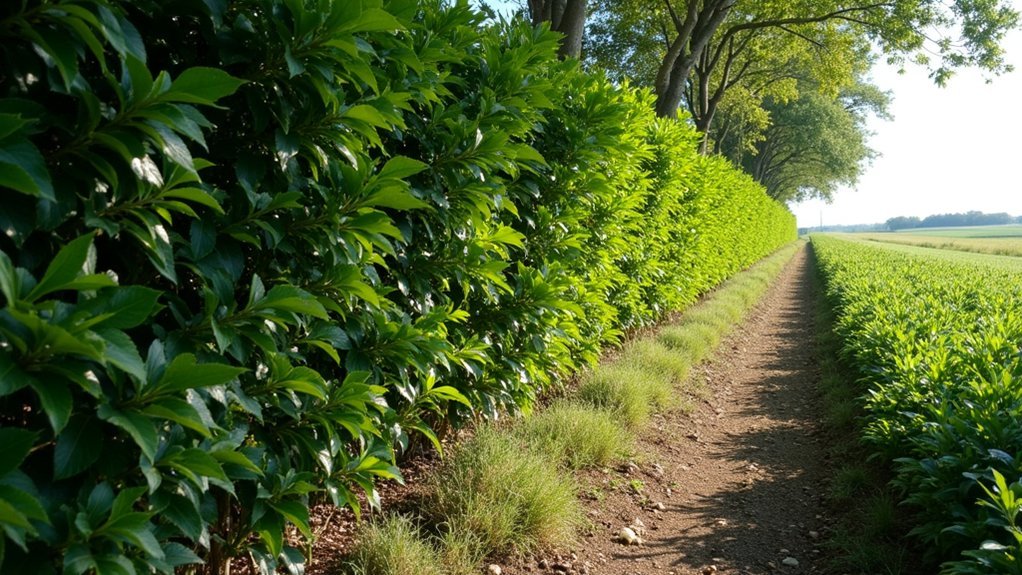For effective living fence windbreaks, plant rows perpendicular to prevailing winds and space them 8-15 feet apart. Within rows, position evergreens 14-20 feet apart, deciduous trees 12-20 feet apart, and shrubs 3-6 feet apart. Aim for 50-65% density with a staggered pattern to eliminate wind gaps. In Texas, adjust spacing wider (20-25 feet) in western regions and closer (10-15 feet) in eastern areas. The right spacing guarantees decades of wind protection without compromising plant health.
Fundamentals of Windbreak Design and Density

When planning your living fence windbreak, proper spacing and density determine its effectiveness at blocking wind and protecting your property. For best results, plant rows perpendicular to prevailing winds, creating a protective zone extending up to 10 times the height of your tallest trees.
Aim for 25-50% density when protecting crops and soil, typically using one row of deciduous shrubs and two rows of trees. For snow protection, increase density to 50-65% with twin rows of deciduous shrubs and evergreens.
Space rows 8-15 feet apart to promote air circulation and reduce competition for natural resources. Within rows, place shrubs 3-6 feet apart, small trees 10-15 feet apart, and conifers 20-25 feet apart.
This balanced approach guarantees healthy growth while maximizing windbreak effectiveness.
Optimal Spacing Guidelines for Different Plant Types
When planning your living fence windbreak, you’ll need different spacing strategies for evergreens versus deciduous trees.
Evergreen conifers require 20-25 feet of spacing both within and between rows to develop their dense, year-round protection while maintaining healthy growth.
Your deciduous trees should be planted 12-20 feet apart within rows and about 20 feet between rows, creating a configuration that maximizes sunlight penetration while still providing effective seasonal protection.
Evergreen Spacing Requirements
Proper spacing forms the foundation of a successful evergreen windbreak. When planting your trees, maintain 10-14 feet between each evergreen within rows to guarantee adequate air circulation and healthy growth.
For multiple-row configurations, allow 20-25 feet between rows to prevent shading issues as trees mature.
Position your evergreen windbreak 60-70 feet from the area you’re protecting to minimize snow drifting while maximizing wind protection. This distance optimizes the windbreak’s effectiveness during winter months.
To build resilience against pests and diseases, incorporate a variety of evergreen species in your windbreak.
If you’re working with limited space, try staggering your plantings while still adhering to minimum spacing guidelines. This approach reduces crowding and guarantees each tree has room to reach its full potential.
Deciduous Tree Configurations
While evergreens provide year-round protection, deciduous trees offer their own unique benefits in a living windbreak system.
When incorporating these seasonal varieties into your windbreak design, you’ll need to space them 12 to 20 feet apart within each row to guarantee they’ve room to reach their full potential.
Maintain at least 20 feet between rows of deciduous trees to prevent overcrowding as they mature. For maximum wind protection, consider planting twin or even three rows with a density of 50-65%.
If your space is limited, try staggering your trees rather than planting them in straight lines.
Select a diverse mix of deciduous trees with varying heights and foliage densities to create a more resilient windbreak that offers multiple ecological benefits throughout the seasons.
Strategic Row Arrangement for Maximum Wind Protection

You’ll need to position your windbreak rows perpendicular to prevailing winds while calculating ideal density between multiple rows (15-30 feet apart).
Stagger your plantings in a zigzag pattern across rows to eliminate gaps that could funnel wind and compromise protection.
Consider the mature height of your trees when planning, as taller species should typically be positioned centrally in your U-, L-, or E-shaped windbreak design.
Multi-Row Density Calculations
Successful windbreaks depend heavily on strategic density planning between rows. For ideal protection, aim for a multi-row density of 50-65%, combining evergreens and deciduous trees in twin rows.
Space shrubs 3-6 feet apart within rows and 6-10 feet between rows, while small trees need 10-15 feet spacing in rows and 20 feet between rows.
- Create wildlife habitat while cutting energy costs with 65%+ density arrangements
- Transform harsh winds into gentle breezes with properly spaced twin-row systems
- Protect your property year-round with evergreen and deciduous combinations
- Prevent future overcrowding by allowing 12-20 feet for deciduous trees
- Customize your windbreak density based on your specific local conditions
Remember to adjust spacing based on your windbreak’s purpose—whether it’s primarily for wind protection, wildlife attraction, or both.
Staggered Planting Patterns
Strategic placement of trees and shrubs in a staggered pattern creates an impenetrable defense against harsh winds, eliminating the gaps that typically allow wind to funnel through traditional straight-line plantings.
When designing your windbreak, position dense shrub species in the row facing prevailing winds, followed by taller trees in subsequent rows.
Space your rows 15-30 feet apart to prevent shading and guarantee proper air circulation. This arrangement maximizes sunlight exposure while creating a varied height profile.
Tree Height Considerations
While staggered patterns create the foundation of your windbreak design, tree height arrangement dramatically influences its protective power. Position your tallest trees in center or back rows to maximize their wind-blocking potential.
Remember, your windbreak’s protection extends up to 10 times the height of your tallest trees, making proper spacing essential.
- Place dense, sturdy shrubs in front rows to create a solid base that redirects rushing winds.
- Create a natural staircase effect with gradually increasing heights from front to back.
- Keep your tallest specimens 60-70 feet from areas you wish to protect to prevent problematic snow drifts.
- Allow adequate spacing between tall trees to accommodate their mature canopy spread.
- Monitor growth patterns annually and adjust your strategy to maintain ideal wind protection as trees mature.
Selecting Compatible Species for Multi-Row Windbreaks

Creating an effective living fence windbreak depends greatly on choosing the right plant combinations that work together harmoniously. Mixing deciduous and evergreen plants not only enhances resistance to pests and diseases but also provides year-round protection against wind.
When planning your windbreak, consider the spacing requirements for different plant types. Shrubs need 3-6 feet between plants and 6-10 feet between rows, while small trees require 10-15 feet of spacing within rows and 20 feet between rows.
Larger deciduous trees should be spaced 12-20 feet apart in rows that are separated by at least 20 feet. For conifers, allow 20-25 feet both within and between rows.
This strategic spacing guarantees plants have adequate access to resources while creating an effective barrier of trees and shrubs without overcrowding.
Site Preparation and Long-Term Spacing Considerations
Before you plant your first seedling, proper site preparation lays the foundation for a successful living fence windbreak. Remove competing vegetation in the fall to give your young seedlings the strongest start.
When positioning plants, maintain 4-6 feet between shrubs, 10-15 feet for small trees, and 20-25 feet between conifers to allow proper development.
Plant trees at least 60-70 feet from areas you want to protect to prevent snow drifting while maximizing wind protection. Monitor and manage spacing for at least three years, filling gaps as needed to maintain your windbreak’s effectiveness.
- Feel the satisfaction of watching your carefully spaced seedlings flourish
- Enjoy the privacy your living fence creates as it matures
- Experience the tranquility of birds nesting in your windbreak
- Celebrate reduced heating costs as your barrier blocks winter winds
- Witness the transformation of your property’s landscape
Regional Adaptations for Texas Climate Zones

Texas presents unique challenges for living fence windbreaks with its diverse climate zones stretching from the humid east to the arid west. Your Tree Planting strategy should adapt accordingly to maximize conservation benefits.
Texas demands region-specific windbreak planning to thrive across its diverse climate zones and deliver optimal conservation results.
In eastern Texas, space trees 10-15 feet between rows and shrubs 6-10 feet apart to capitalize on higher rainfall while still creating effective wind barriers.
Western regions require wider 20-25 foot spacing to prevent excessive moisture loss and competition in arid conditions.
Select native species like Eastern redcedar or mesquite that have naturally adapted to local conditions. These natives resist regional pests and diseases while requiring less maintenance.
Always adjust your spacing based on your specific property’s soil type and topography. These adaptations guarantee your windbreak will effectively mitigate wind damage while thriving in Texas’ challenging climate variations.
Maintenance Practices to Preserve Windbreak Effectiveness
While establishing your living fence windbreak represents a significant achievement, maintaining its effectiveness requires consistent attention and care.
Regular monitoring guarantees your windbreak continues to protect crops from harsh winds. Plants positioned just a few feet apart need proper spacing adjustments as they mature to prevent overcrowding while maintaining protection.
- Conduct health assessments every three months to catch pest issues before they devastate your protective barrier.
- Promptly fill gaps in planting rows to prevent wind tunnels that could damage vulnerable crops.
- Maintain uniform plant varieties within rows for peak wind deflection.
- Remove competing vegetation that steals nutrients from your windbreak specimens.
- Adjust spacing between plants as needed to balance growth with maximum protection.
Frequently Asked Questions
How Far Apart Should I Plant Trees for a Windbreak?
For a windbreak, you’ll need to space small trees 10-15 feet apart, deciduous trees 12-20 feet apart, and conifers 20-25 feet apart. Maintain 20 feet between rows for ideal airflow and protection.
What Is the Effective Distance for a Windbreak?
Your windbreak’s effective distance extends roughly 10 times the height of your tallest trees. You’ll get maximum protection within this zone, while maintaining 60-70 feet between trees and protected areas prevents snow drifting issues.
How Far Apart Do You Plant White Pine for Windbreak?
You’ll want to plant white pines 20-25 feet apart in your windbreak. Space rows at least 20 feet apart to prevent shading. This spacing allows proper growth while creating an effective wind barrier.
What Are the Disadvantages of Windbreak Farming?
You’ll face crop competition for sunlight, harmful wind eddies from poor design, pest harboring risks, limited field access for equipment, and potential waterlogging issues. These disadvantages require careful planning to minimize their impact on your farm.
In Summary
When you’re planting your living fence windbreak, remember that proper spacing isn’t just about aesthetics—it’s vital for effectiveness. You’ll need to balance density with airflow, choose compatible species, and adapt to Texas’ unique climate zones. Don’t neglect ongoing maintenance as your plants mature. With careful planning and proper spacing, your windbreak will protect your property while enhancing its beauty for years to come.





Leave a Reply